Introduction
In 2011, UK vessels landed 600 thousand tonnes of sea fish (including shellfish) into the UK and
abroad with a value of 828 million. This represents a 1 per cent fall in quantity but a 15 per cent
increase in value compared with 2010.
This chapter provides a comprehensive overview of the weight and value of landings by UK
vessels into the UK and abroad and by foreign vessels into the UK. The publication includes
breakdowns of landings data according to:
- Vessel nationality
- Port and country of landing
- Area of capture and fishing gear used
- Vessel size and sectoral membership
Data are also provided on landings and quota uptake for all EU member states. All landings data
are given in terms of live weight.
All tables presented here are available to download as spreadsheets from the MMO website.
Supplementary tables showing more detail can also be found on the website.
Landings by all UK Vessels and by Foreign Vessels into the UK
Sixty seven per cent of fish caught by the UK fleet were landed in the UK. In terms of value, 75 per cent of UK vessel landings were made in the UK. Chart 3.1 shows the landings into the UK and abroad by vessel nationality. Scottish vessels accounted for 60 per cent of the weight and the value of landings by UK vessels (see Table 3.1). English vessels accounted for 28 per cent of the quantity and 30 per cent of the value of the landings, while Welsh and Northern Irish vessels represented 3 and 8 per cent by quantity respectively.
Quantity and Value of Landings into the UK and Abroad by UK Vessels by Vessel Nationality: 2007 to 2011
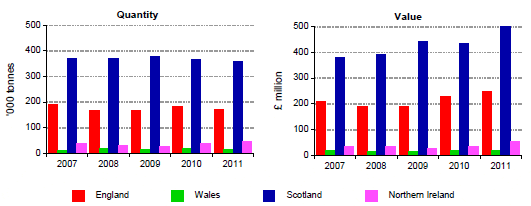
Landings by UK vessels into the UK fell by 2 per cent to 404 thousand tonnes in 2011. Demersal
species represented 27 per cent of these landings in terms of quantity and 34 per cent in terms of
value. Pelagic species accounted for 36 per cent of landings by quantity but only 21 per cent by
value. Shellfish accounted for 37 per cent of landings by quantity and 45 per cent by value. This is
the first time that shellfish has had the largest share of tonnage landed.
Chart 3.2 shows a breakdown of landings by species group into England, Wales, Scotland and
Northern Ireland by UK vessels. The largest amount, 260 thousand tonnes, was landed into
Scotland with a value of 406 million. Landings into England were 99 thousand tonnes with a value
of 164 million.
Landings into UK Countries by UK Vessels: 2011 (000 Tonnes)

Breakdowns by species of landings into the UK by UK vessels, landings into the UK by foreign vessels and landings abroad by UK vessels are given in Tables 3.2 to 3.6. In 2011:
- The UK fleet accounted for 86 per cent of all fish landed into the UK (see Tables 3.2 and 3.4). Only 39 per cent of blue whiting landed into the UK is caught by UK vessels. For all other species, the majority of UK landings are made by UK vessels.
- Shellfish formed a majority of landings by the UK fleet into England, Wales and Northern Ireland. Pelagic fish had the highest share of landings into Scotland (see Tables 3.2a to 3.2d and Chart 3.2).
- Landings into the UK by foreign vessels fell by 39 per cent to 67 thousand tonnes (see Table 3.3). This was a result of a large fall in blue whiting but landings of mackerel also fell. Blue whiting has a relatively low value and so the overall reduction in the value of foreign landings into the UK was only 3 per cent.
- Nearly half of all landings of pelagic fish by UK vessels were landed abroad (see Tables 3.5 and 3.6). In contrast, only 4 per cent of shellfish landings by the UK fleet were made abroad.
Information on all landings into the UK, by UK and foreign vessels, going back as far as 1938 is
shown in Table 3.7. Landings of demersal fish in 2011 were less than a fifth of the quantity landed
in 1960. The decline in landings of demersal fish has a number of causes, including reductions in
fleet size, declining fish stocks and restricted fishing opportunities. EU and UK regulation has
limited demersal fishing activity in recent decades, through decommissioning of fishing vessels,
reductions in quotas and fishing effort limits and other provisions of stock management plans.
Landings of pelagic species have increased by more than 40 per cent over the same period,
despite a large fall in 2011. Landings of pelagic fish have fluctuated considerably over the last 50
years. Many pelagic species are under stock management plans with quotas set by the European
Commission, but pelagic landings have not seen the same reduction as demersal species.
Over the past 50 years, reported landings of shellfish into the UK have increased by more than a
factor of 5. The increase in shellfish landings into the UK may partly be explained by diversion of
fishing activity into this sector, in which there are often fewer restrictions. For example, quotas
currently only apply to nephrops. Another factor in the perceived increase is improved reporting. A
large proportion of shellfish landings are made by vessels 10 metres or under, for which there is no
statutory obligation to complete a fishing logbook or landing declaration. Successive improvements
in data collection for this sector in recent years, including the introduction of mandatory reporting of
first sales of fish, may account for some of the increase in reported landings.
Demersal, Pelagic and Shellfish Landings
In 2011, the UK fleet landed 160 thousand tonnes of demersal species, 5 per cent lower than in
2010. Over the same period, the value of demersal landings increased by 5 per cent to 288
million. In 2011, 282 thousand tonnes of pelagic species were landed, down 1 per cent on 2010,
while the value has increased substantially by 39 per cent to 249 million. This is largely driven by
a rise in market prices for mackerel.
Shellfish landings rose for the second consecutive year to 158 thousand tonnes, an increase of 15
per cent on 2009 levels. Over the same period the value of shellfish landings increased by 20 per
cent to 291 million.
Landings into the UK and Abroad by UK Vessels: 2007 to 2011
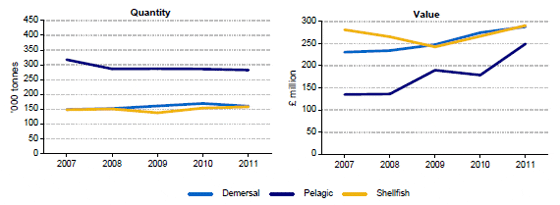
Demersal Fish
Cod, haddock and plaice are the three main demersal species landed by the UK fleet in terms of
weight, accounting for 44 per cent of all demersal species landed in 2011.
Cod landings have fallen considerably since 1995 although there have been some relatively small
increases in recent years. However in 2011, landings of cod by the UK fleet fell by 10 per cent on
2010 levels to 23 thousand tonnes while the value of cod landings increased by 2 per cent to 46
million. Landings of cod into the UK by foreign vessels has fallen to a little over 1 thousand tonnes
in 2011 compared with 14 thousand tonnes in 2009. Forty five per cent of the quantity of cod
landed by UK vessels was outside the UK.
Landings of Key Demersal Species into the UK and Abroad by UK Vessels: 1995 to 2011
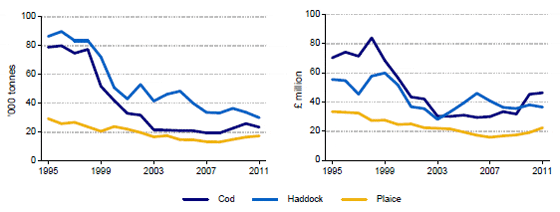
The average price of cod increased by 14 per cent in 2011 to 2.00 per kilogram compared with
1.76 per kilogram in 2010.
Haddock remains the most important species in terms of quantity landed. This is despite a fall of 18
per cent in landings by the UK fleet over the last two years to 30 thousand tonnes. Only 5 per cent
of haddock was landed abroad. Landings of haddock into the UK by foreign vessels fell by around
80 per cent over the same period to less than 1 thousand tonnes. The average price of haddock
was 1.22 per kilogram in 2011.
Plaice landings by the UK fleet continued to increase to 17 thousand tonnes in 2011, up by almost
a third in three years. Eighty three per cent of the quantity of plaice landed by the UK fleet in 2011
was landed abroad. The average price of plaice landed by the UK fleet has risen by 12 per cent in
2011 to 1.31 per kilogram.
For other demersal species:
- The flatfish turbot and sole commanded the highest prices of demersal species landed by the UK fleet in 2011 at 9.13 per kilogram and 9.02 per kilogram respectively.
- Monks or anglers accounted for the largest total value of demersal fish landed by the UK fleet in 2011, with 51 million landed.
- Virtually all landings of sand eels by the UK fleet were made abroad. In contrast, 97 per cent of the quantity of whiting landings by the UK fleet was into the UK.
Landings of Key Demersal Species into the UK by UK Vessels by Month: 2011
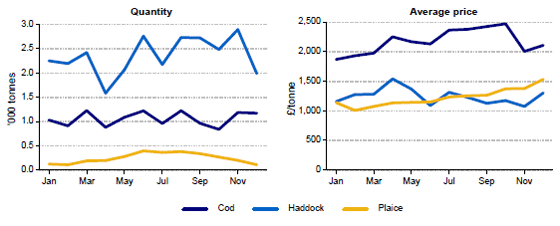
Landings of cod by UK vessels into the UK fluctuated between 800 and 1,250 tonnes per month
during 2011 (Chart 3.5). The majority of these landings are captured in the North Sea (ICES subarea
IV). Average prices for cod landed into the UK by the UK fleet peaked in October at 2.47 per
kilogram, which was also when the lowest catch was recorded.
Haddock landings by UK vessels into the UK ranged from a peak of 2,900 tonnes in November to a
low of 1,600 tonnes in April.
Landings of plaice by UK vessels into the UK peaked during the summer months of 2011. The
average monthly price of plaice was similar to that for haddock.
Chart 3.6 shows that the largest amounts of demersal fish landed abroad by the UK fleet were into
the Netherlands and Denmark (15 and 13 thousand tonnes respectively). France tops the list of
foreign vessels landing into the UK, with 14 thousand tonnes. This is 48 per cent of all foreign
demersal landings into the UK.
Landings of Demersal Species Abroad by UK Vessels and Landings into the UK by Foreign Vessels: 2011
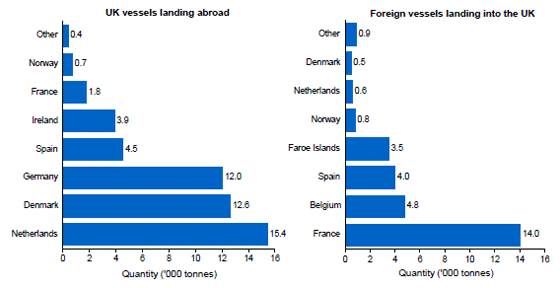
Chart 3.7 shows landings of demersal species by the UK fleet in 2011 by ICES rectangle of capture. Large quantities of demersal species were captured to the north-east of Scotland, in the central North Sea and in the English Channel. These fishing grounds also yielded the highest total value of demersal species per rectangle. However, demersal species with the highest average prices were captured from waters to the south and west of the UK and Ireland.
Demersal Landings by UK Vessels by ICES Rectangle: 2011(a)
Quantity of Landings by ICES Rectangle
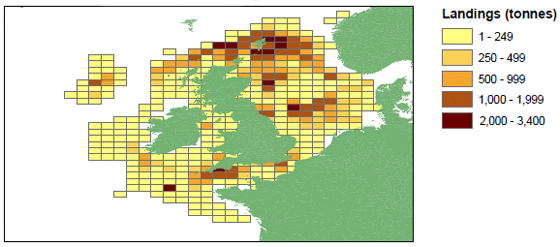
Value of Landings by ICES Rectangle

Value of Landings Per Tonne by ICES Rectangle
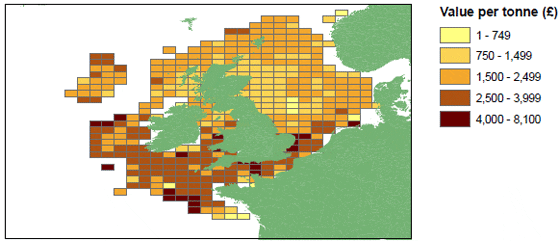
Note: The upper data limits are different from those used for 2010 in last year's publication.
Pelagic fish
Mackerel and herring are the two main pelagic species landed by the UK fleet. These species
accounted for 86 per cent by weight and 94 per cent by value of total pelagic landings in 2011, and
41 per cent of the quantity of all landings by the UK fleet.
The UK fleet catches more mackerel than any other species. In 2011, landings of mackerel by UK
vessels increased by 13 per cent to 182 thousand tonnes. The total value of landings increased by
48 per cent to 205 million. The average price of mackerel increased from 0.86 per kilogram in
2010 to 1.13 per kilogram in 2011 making it by far the most expensive pelagic fish. Mackerel is
also the species with the greatest quantity (24 thousand tonnes) and value (33 million) landed by
foreign vessels into the UK. However, landings in 2011 were down from the recent peak of 39
thousand tonnes in 2010.
Herring landings by UK vessels have been fairly flat in recent years but fell by 8 per cent to 62
thousand tonnes in 2011 with a value of 29 million. Fifty one per cent of this was landed into the
UK. The average price of herring for the UK fleet increased from 0.33 a kilogram in 2010 to 0.48
per kilogram in 2011. Landings of herring by foreign countries into the UK have fallen dramatically
in recent years but rose from 5 thousand tonnes in 2010 to 8 thousand tonnes in 2011.
Landings of Key Pelagic Species into the UK and Abroad by UK Vessels: 1995 to 2011
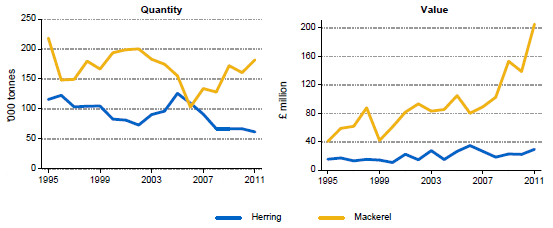
Longer-term trends in mackerel and herring landings by the UK fleet show much fluctuation (see
Chart 3.8). Herring landings in 2011 were at their lowest levels for well over a decade, following a
peak of 126 thousand tonnes in 2005. Although mackerel landings have increased in recent years,
they were still lower than levels recorded in 1995.
For other pelagic species:
- Landings of blue whiting have fallen substantially in 2011 to just over 1 thousand tonnes. Similarly, landings of blue whiting by foreign vessels also fell sharply to 2 thousand tonnes. These are both a result of cuts in the quotas set by the European Commission.
- UK fleet landings of horse mackerel have remained fairly constant but landings of sardines fell from 24 thousand tonnes in 2010 to 10 thousand tonnes in 2011.
The mackerel fishery generally takes place in January, September and October. Fifty seven per cent of all mackerel landings into the UK by the UK fleet in 2011 were in January, with a further 36 per cent in September and October. The sources of these two peaks are different: whereas the January peak derives almost entirely from landings captured in ICES sub-areas VI and VII, the mackerel landings in September and October come from a fishery in the North Sea (ICES sub-area IV). Monthly average prices for mackerel ranged from 750 per tonne to 2,150 per tonne and generally grew as the year progressed.
Landings of Key Pelagic Species into the UK by UK Vessels by Month: 2011

February, August and September are the key months for herring. Around a quarter of all herring
landed into the UK by the UK fleet was landed in February, with a further 56 per cent landed in
August and September. As with mackerel, different fisheries are the source of the two peaks.
Landings in February came chiefly from ICES sub-area II, whereas those in August and September
were from fisheries in the North Sea (ICES sub-area IV) and the West of Scotland and Rockall
(ICES sub-area VI). The monthly average price of herring was relatively flat.
The largest quantities of pelagic species landed by the UK fleet abroad were into Norway and the
Netherlands at 77 and 39 thousand tonnes respectively (Chart 3.10). Norwegian vessels landed 14
thousand tonnes into the UK, accounting for 37 per cent of pelagic landings by foreign vessels into
the UK.
Landings of Pelagic Species abroad by UK Vessels and Landings into the UK by Foreign Vessels: 2011
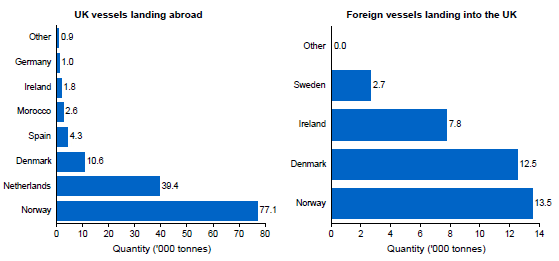
Chart 3.11 shows that large quantities and values of pelagic species were captured from rectangles near Shetland, Orkney and the north-west of Scotland and Ireland. However, pelagic species with high prices were caught in rectangles to the south-west of Ireland and in the central North Sea.
Shellfish
Scallops, nephrops and crabs are the three main species of shellfish landed by UK vessels into the
UK and abroad, accounting for 76 per cent of the quantity and 74 per cent of the value landed in
2011.
Scallops accounted for 35 per cent of the quantity and 22 per cent of the value of shellfish landings
by the UK fleet in 2011. Only 4 per cent of this was landed abroad. Landings of scallops by the UK
fleet have increased by a factor of 3 since 1995, with the bulk of the increase occurring since 2008.
Part of this increase is due to a diversion of activity into this relatively less regulated fishery from
demersal and pelagic fisheries subject to catch limits.
Nephrops formed around a fifth of the weight of shellfish landings by the UK fleet and 39 per cent
of the value, at 35 thousand tonnes and 113 million, respectively. Almost all of this was landed
into the UK. Landings of nephrops into the UK by foreign vessels were negligible in comparison.
Landings of nephrops by the UK fleet have increased in recent years but have now fallen back to
levels similar to those seen in 1995.
In 2011, landings of crabs by the UK fleet totalled 30 thousand tonnes with a value of 40 million.
This formed 19 per cent of the weight and 14 per cent of the value of all shellfish landings by the
UK fleet. Six per cent of these landings (2 thousand tonnes) were outside the UK. As with other
shellfish species, landings of crabs by the UK fleet have increased since 1995.
Landings of Key Shellfish Species into the UK and Abroad by UK Vessels: 1995 to 2011
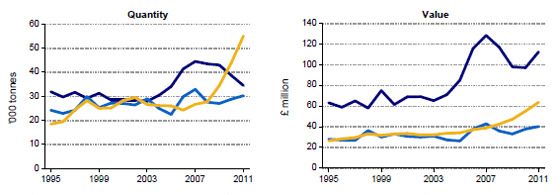
For other shellfish species:
- Lobsters commanded the highest average price of all species landed by the UK fleet at 10.19 per kilogram in 2011. While lobsters accounted for only 2 per cent of the weight of shellfish landings by the UK fleet, they formed 11 per cent of the value.
- Shrimp and prawn landings by the UK fleet fell from 4 thousand tonnes in 2010 to just 400 tonnes in 2011.
- Landings of cockles by the UK fleet in 2011 also fell dramatically and were a twentieth of their quantity in 2008.
Landings of scallops into the UK by the UK fleet ranged from a low of 3,100 tonnes in May to a high of 5,600 tonnes in March. The largest landings of nephrops occurred during summer months. Average prices of nephrops landed into the UK by the UK fleet surged in late 2011 to a high of 4.39 per kilogram after remaining around 3.00 per kilogram for much of the year. Crab landings rose during 2011, from a low of 1,100 tonnes in February to a peak of 3,600 tonnes in October.
Landings of Key Shellfish Species into the UK by UK Vessels by Month: 2011
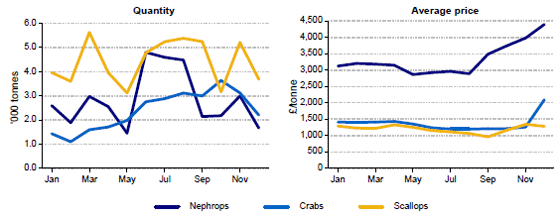
Only small quantities of shellfish were landed abroad by the UK fleet, with an even smaller amount landed by foreign vessels into the UK in 2011. Chart 3.14 shows the largest amounts of shellfish landed abroad by the UK fleet were into Ireland and Spain (3 and 2 thousand tonnes respectively). Vessels from Belgium landed 580 tonnes of shellfish into the UK.
Landings of Shellfish Species Abroad by UK Vessels and Landings into the UK by Foreign Vessels: 2011
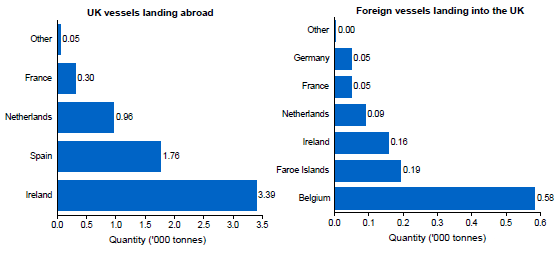
Chart 3.15 shows landings of shellfish by the UK fleet in 2011 by ICES rectangle of capture. In 2011, both the largest quantity and value of shellfish were captured in rectangles around the coast of the UK. However, shellfish species with high prices were typically captured in rectangles away from coastal areas.
Landings into Major Ports by the UK Fleet
Chart 3.16 shows the top twenty UK ports based on the quantity landed by UK vessels in 2011.
Peterhead remains the port with highest landings of 107 thousand tonnes, down from 122
thousand tonnes in 2010. Lerwick is still in second place with 52 thousand tonnes and Fraserburgh
remains third highest with landings of 25 thousand tonnes. Landings in Lerwick and Fraserburgh
fell by 6 per cent and 7 per cent respectively.
Plymouth remains the port with the largest quantity of landings in England (14 thousand tonnes);
however, Brixham had the highest value of landings in 2011 (26 million). This is largely due to the
different species landed into each port: Brixham receives much greater proportions of demersal fish
and shellfish, which typically sell at higher prices per tonne than pelagic species, which constitute
the majority of landings into Plymouth.
Landings into the Top 20 UK Ports by UK Vessels: 2011
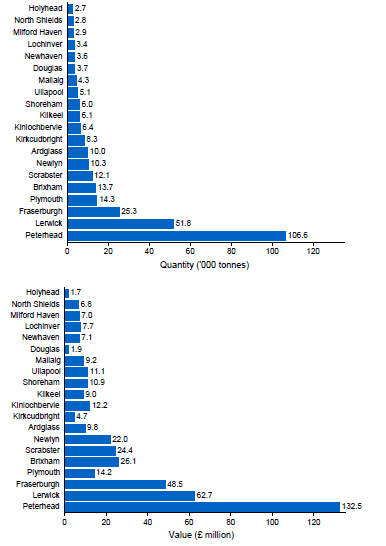
This difference in species composition of landings is illustrated in Chart 3.17, which shows the
quantity of demersal, pelagic and shellfish landings across the top 20 UK ports identified in Chart
3.16. The relatively low value per tonne of landings into Peterhead, Lerwick, Plymouth and
Ardglass is because these are the only ports in the top 20 where the majority of fish landed are
pelagic species. Landings into these four ports account for 85 per cent of landings of pelagic
species into the UK by the UK fleet.
Landings into the top three ports in Scotland constitute 71 per cent of all landings by UK vessels
into Scotland by quantity. In contrast, landings into Plymouth, Brixham and Newlyn form only 39
per cent of landings by UK vessels into England, with remaining landings more evenly spread
around the English coast. The low number of English ports in Charts 3.16 and 3.17 is explained by
the broad distribution of landings across English ports.
Landings Abroad by the UK Fleet
In 2011, UK vessels landed 196 thousand tonnes of fish abroad. Of this, the UK landed 78
thousand tonnes into Norway, of which 99 per cent were pelagic species. Fifty six thousand tonnes
were landed by UK vessels into the Netherlands and 23 thousand tonnes into Denmark. A small
sector of the UK registered fishing fleet is in Dutch economic ownership; landings by these vessels
contribute to the large quantities of fish landed into the Netherlands. Chart 3.18 shows the quantity
of fish landed into each country, where this exceeds one thousand tonnes.
Seventy per cent of fish landed abroad by UK vessels were pelagic and 26 per cent were
demersal. Different countries receive different species: the majority of fish landed into Denmark
and Germany were demersal. The species landed into each country is typically determined by
market conditions and consumer tastes.
Landings into the UK by Foreign Vessels
In 2011, 67 thousand tonnes of fish were landed into the UK by foreign vessels, down from 109
thousand tonnes in 2010. This fall is largely a result of a reduction in the amounts of blue whiting
and mackerel landed. Chart 3.19 shows the quantities landed by vessel nationality, where these
exceed one thousand tonnes.
Norwegian and French registered vessels landed the largest quantity of fish into the UK in 2011 (14
thousand tonnes each). The majority of fish landed into the UK by foreign registered vessels are
pelagic (55 per cent); two thirds of this is mackerel.
Landings by the UK Fleet by Area of Capture
Table 3.8 and Chart 3.20 show that over a quarter of the quantity of fish landed by UK vessels in
2011 was caught in the Northern North Sea (ICES division IVa), a total of 171 thousand tonnes.
Large quantities were also caught in West of Scotland (ICES division VIa) and the English Channel
(ICES divisions VIId/e): 161 thousand tonnes and 60 thousand tonnes, respectively.
Different sea areas yield different proportions of species. The North Sea (ICES divisions IVa, IVb
and IVc) provided 60 per cent of the demersal fish landed by the UK fleet, while the West of
Scotland was the source of 41 per cent of pelagic fish landed by UK vessels in 2011. The Irish Sea
(ICES division VIIa) provided 29 per cent of the shellfish landed by the UK fleet. Typically, shellfish
landings form a high proportion of landings from enclosed sea areas with large coastal stretches
(Irish Sea, Bristol Channel, English Channel), while pelagic species form the majority of landings
from open waters such as the West of Scotland, West of Ireland (ICES division VIIb) and
Little/Great Sole Bank (ICES division VIIh/j).
Landings by the UK Fleet by Sector
Eighty four per cent of the quantity of all landings by the UK fleet in 2011 was landed by vessels in
a producer organisation. Table 3.9 shows the quantity and value of landings by the different sectors
of the UK fleet.
Vessels in the Scottish FPO landed 20 per cent of the quantity and 19 per cent of the value of fish
landed by UK vessels (118 thousand tonnes, 158 million). Scottish FPO vessels accounted for
almost a quarter of the quantity of all demersal fish and pelagic fish landed by UK vessels.
There is clear specialisation among producer organisations with regard to species targeted. For
example, vessels in North Atlantic FPO, Lunar Group, Interfish and Klondyke primarily targeted
pelagic species in 2011, landing only negligible quantities of demersal species and shellfish but
almost half the quantity of pelagic fish landed by UK vessels.
Around a third of UK vessels were in the non-sector at the end of 2011 (vessels over 10 metres in
overall length without producer organisation membership). These vessels typically have limited
access to fishing quota and primarily target shellfish species, which are mostly non-quota stocks. In
2011 they landed 32 per cent of all shellfish landed by the UK fleet. Vessels in the non-sector
landed only negligible quantities of demersal and pelagic species.
Vessels 10 metres and under in length without producer organisation membership (the 10m and
under pool) also landed relatively small quantities of demersal and pelagic species. Three quarters
of their catch in terms of quantity and value is shellfish. Despite landing 19 per cent of all shellfish
landed by the UK fleet during 2011, the fishing methods used by this sector and the different
species targeted mean that they accounted for 24 per cent of the total shellfish value.
Landings by the UK Fleet by Vessel Length
Sixty nine per cent of the quantity of landings by the UK fleet in 2011 was caught by vessels over
24 metres in length. At the end of 2011, these vessels constituted just 4 per cent of the UK fleet by
number, yet their landings of pelagic species formed 96 per cent of the annual total for the UK fleet.
Eighty nine per cent of all landings of demersal species by the UK fleet were by vessels over 18
metres in length. In contrast, landings of shellfish are much more evenly distributed across the
fleet, with vessels 10 metres and under in length (including those in producer organisations)
accounting for 20 per cent of the quantity of landings.
Although on average longer vessels land much greater quantities of fish than their smaller
counterparts, they typically achieve a much lower average price for the fish landed (Chart 3.21).
For example, the average price of demersal fish landed by vessels over 24 metres is 1.68 per
kilogram, while for the 8 metre and under fleet this is more than double, at 3.71 per kilogram.
Similar differences apply for shellfish, with an average price of 3.03 per kilogram for landings by
the 8 metre and under fleet, compared with 1.69 per kilogram for the over 24 metre fleet. The
difference in prices is partly due to differences in species targeted, fishing methods used and
choice of markets.
Average Price of Landings into the UK and Abroad by UK Vessels by Vessel Length: 2011
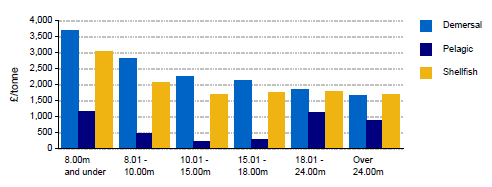
Landings by the UK Fleet by Gear Used
Eighty eight per cent of fish landed by UK vessels in 2011 was captured using mobile gears, such
as beam trawls, demersal trawls and seines, pelagic seines and dredges (see Table 3.11). Almost
all landings of pelagic fish and 90 per cent of all demersal fish were caught using mobile gears.
Passive gears were used to catch a third of the shellfish landed by the UK fleet in 2011.
The majority of demersal and pelagic fish landed by UK vessels in 2011 were captured using
demersal trawls and seines. This broad category includes otter, nephrops, shrimp and pair trawls,
and all demersal seines. Dredges were used to capture 37 per cent of the shellfish landed by the
UK fleet; the remainder were chiefly caught using pots and traps (31 per cent) and demersal trawls
and seines (28 per cent).
The average price of fish landed by the UK fleet which was captured using passive gears greatly
exceeds that for fish captured by mobile gears (2.07 per kilogram compared with 1.29 per
kilogram). This difference is maintained across species groups. Price differentials are also
observed between different gears of the same class. For example, shellfish caught using dredges
were sold at an average price of 1.06 per kilogram, while shellfish caught using demersal trawls
and seines were sold at an average price of 2.66 per kilogram.
This variation in prices partly reflects the different species caught by different gears. For example,
demersal trawls and seines capture the majority of the nephrops landed by the UK fleet, while the
bulk of the landings from dredges are scallops, which sell at a lower average price. However, there
can also be a premium attached to the method by which the fish are captured.
Uptake of Quotas by EU Member States
Table 3.12 shows the quota held by EU member states at the end of 2011 (after international quota
transfers) for each stock, together with landings by each member state during 2011. The shares of
the quota held by each member state vary considerably across stocks, with different countries
landing different quantities of each stock as a consequence.
Chart 3.22 illustrates the difference in landings by member states for stocks of major importance to
the UK and other EU countries. In 2011, the UK landed 93 per cent of all North Sea haddock (23
thousand tonnes) and 85 per cent of all North Sea nephrops (14 thousand tonnes) landed by
member states. This dominance is not seen across all North Sea stocks. For example, Danish
vessels landed 85 per cent of all North Sea sand eels, whereas Dutch vessels landed 73 per cent
of all North Sea sole.
Share of Landings of Key Stocks by EU Member States: 2011
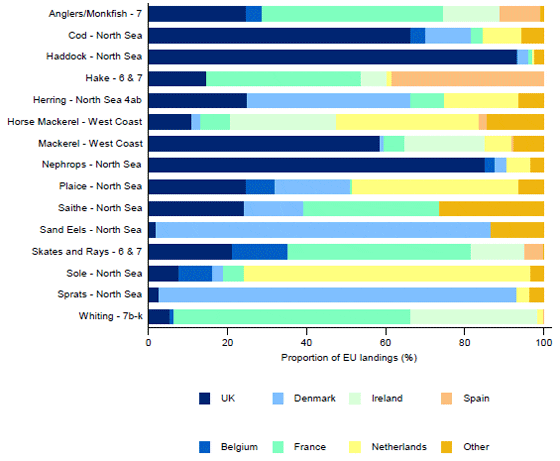
Note: The data in this chart are official statistics and not subject to National Statistics accreditation.
The figures here are derived from reports to the European Commission by each member state detailing landings into their own country by their own vessels and those of other member states. The figures for the UK may therefore differ from those reported earlier in this chapter, which are based solely on the UKs record of landings into the UK and abroad.
December 2012



